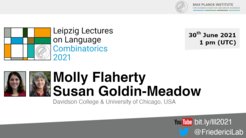
Molly Flaherty & Susan Goldin-Meadow
Lecture 5 | Leipzig Lectures on Language—Combinatorics 2021
The resilience of language

Language is the product of human minds and human interactions, but science is generally unable to observe how linguistic structure emerges because generations of use and transmission shape and reshape the structure of the languages themselves. Here we examine the emergence of natural language structure in two unusual circumstances: the case of deaf children with no access to signed languages but who invent their own gesture languages (homesigns), and the case of a brand new natural language, Nicaraguan Sign Language (NSL). NSL emerged with the founding of a new school in Managua approximately forty years ago. Over successive generations of signers, the language grows and changes. By comparing the communicative systems invented by homesigners, who do not have deaf peers to communicate with or learn from, and NSL signers of different generations, we can observe the emergence of linguistic structure and examine the roles of the individual, the community, and transmission in language creation.
About the speakers
Molly Flaherty is Assistant Professor in the Department of Psychology at Davidson College. In her research, she seeks to better understand the developing human mind by closely examining the structure of language. Her work explores the emergence of linguistic structure in one of the youngest languages known to science: Nicaraguan Sign Language (NSL).
Susan Goldin-Meadow is Professor in the Department of Psychology at the University of Chicago. Her main research interests include language development and creation, and the role of gesture in communicating, thinking, and learning.
Keywords: language processing; language acquisition; language evolution; sign language; gesture processing
